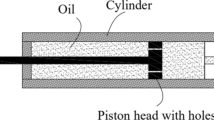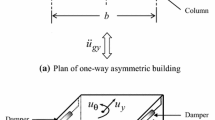Abstract
Two analytical studies for the seismic response of a multi-degree-of-freedom shear model controlled by pseudo-negative stiffness (PNS) device and true negative stiffness (TNS) device are presented. The first study intends to optimise the parameters of the control devices for maximum response reduction. The optimal number and location of devices required to achieve the optimal reduction of seismic responses are investigated. In the second study, the performance of the negative stiffness devices, TNS and PNS, are compared with each other and also with a conventional viscous fluid damper (VFD) based on their seismic response reduction capability; different control strategies are adopted for the comparison. The building model considered is a shear type, lumped mass one with a lateral degree-of-freedom at each floor. The governing equations of motion are solved using Newmark’s beta method for a linear variation at a small time interval for six earthquake ground motions. The results indicate that the PNS and TNS devices performed better than the conventional VFD. However, the negative stiffness behaviour of the devices tends to increase certain responses as compared to the conventional damper. Furthermore, the addition of a conventional damper was found to improve the negative stiffness device’s performance as the possible increase in deformation due to such devices is controlled.















Similar content being viewed by others
References
Attary, N., Symans, M., Nagarajaiah, S., Reinhorn, A. M., Constantinou, M. C., Sarlis, A. A., et al. (2015). Numerical simulations of a highway bridge structure employing passive negative stiffness device for seismic protection. Earthquake Engineering and Structural Dynamics, 44(6), 973–995.
Attary, N., Symans, M. D., Nagarajaiah, S., Reinhorn, A. M., Constantinou, M. C., Taylor, D., & Sarlis, A. A. (2012). Performance evaluation of a seismically isolated bridge structure with adaptive passive negative stiffness. In Proceedings of Fifteenth World Conference on Earthquake Engineering (15WCEE).
Attary, N., Symans, M. D., Nagarajaiah, S., Reinhorn, A. M., Constantinou, M. C., Taylor, D., Sarlis, A. A., & Pasala, D. T. R. (2012). Application of negative stiffness devices for seismic protection of bridge structures. In Proceedings of 2012 ASCE Structures Congress.
Bakre, S. V., & Jangid, R. S. (2004). Optimum multiple tuned mass dampers for base-excited damped main system. International Journal of Structural Stability and Dynamics, 4(4), 527–542.
Bhatti, A. Q., & Varum. H. (2012). Comparison between the visco-elastic dampers and magnetorheological dampers and study the effect of temperature on the damping properties. In Proceedings of 15th WCEE, World Conference on Earthquake Engineering.
Carrella, A., Brennan, M. J., & Waters, T. P. (2007). Static analysis of a passive vibration isolator with quasi-zero-stiffness characteristic. Journal of Sound and Vibration, 301(3), 678–689.
Carrella, A., Brennan, M. J., Waters, T. P., & Shin, K. (2008). On the design of a high-static–low-dynamic stiffness isolator using linear mechanical springs and magnets. Journal of Sound and Vibration, 315(3), 712–720.
Fu, Y., & Cherry, S. (2000). Performance comparison of different friction damped systems. In Proceedings of 15th WCEE, World Conference on Earthquake Engineering: Vol 5. (pp. 1–8).
Iemura, H., Igarashi, A., & Kalantari, A. (2004). Enhancing dynamic performance of liquid storage tanks by semi-active controlled dampers. In Proceedings of the 13th World Conference on Earthquake Engineering. Vancouver, BC, Canada.
Iemura, H., Igarashi, A., & Nakata, N. (2001). Semi-active control of full-scale structures using variable joint damper system. In The 14th KKNN Symposium on Civil Engineering (pp. 41–46). Kyoto, Japan.
Iemura, H., Igarashi, A., Toyooka, A., Kouchiyama, O., & Higuchi, M. (2008). Seismic response control with innovative negative stiffness dampers. In Proceedings of the 14th World Conference on Structural Control and Monitoring, Beijing, China.
Iemura, H., & Pradono, M. H. (2002). Passive and semi-active seismic response control of a cable-stayed bridge. Journal of Structural Control, 9(3), 189–204.
Iemura, H., & Pradono, M. H. (2003). Application of pseudo-negative stiffness control to the benchmark cable-stayed bridge. Journal of Structural Control, 10(3), 187–203.
Madhekar, S. N., & Jangid, R. S. (2012). Use of pseudo-negative stiffness dampers for reducing the seismic response of bridges: a benchmark study. Bulletin of Earthquake Engineering, 10(5), 1561–1583.
Mathew, G. M., Qureshi, A., & Jangid, R. S. (2015). Optimal placement of negative stiffness damping system, conference on smart materials. In Adaptive Structures and Intelligent Systems, American Society of Mechanical Engineers, Colorado, USA.
Nagarajaiah, S., Reinhorn, A. M., Constantinou, M. C., Taylor, D., Pasala, D. T. R., & Sarlis, A. A. (2010). Adaptive negative stiffness: a new structural modification approach for seismic protection. In Proceedings of Fifth World Conference on Earthquake Engineering (5WCEE).
Pasala, D. T. R. (2013). Seismic response control of structures using novel adaptive passive and semi-active variable stiffness and negative stiffness devices. Doctoral dissertation, Rice University.
Pasala, D. T. R., Sarlis, A. A., Reinhorn, A. M., Nagarajaiah, S., Constantinou, M. C., & Taylor, D. (2013). Simulated bilinear-elastic behavior in a SDOF elastic structure using negative stiffness device: Experimental and analytical study. Journal of Structural Engineering, 140(2), 1943–1954.
Platus, D. L. (1992). Negative-stiffness-mechanism vibration isolation systems. In Proceedings of Vibration Control in Microelectronics, Optics, and Metrology: vol 1619. (pp. 44–54) San Jose.
Reigles, D. G., & Symans, M. D. (2005). Systematic performance evaluation of smart seismic isolation systems. Structures Congress: Metropolis and Beyond, 1–12.
Reinhorn, A. M., Viti, S., & Cimellaro, G. (2005). Retrofit of structures: Strength reduction with damping enhancement. In Proceedings of the 37th UJNR panel meeting on wind and seismic effects (pp. 16-21). Tsukuba.
Sarlis, A. A. (2013). Adaptive seismic protection systems (Ph. D. Thesis). University at Buffalo, SUNY, Buffalo, NY.
Sarlis, A. A., Pasala, D. T. R., Constantinou, M. C., Reinhorn, A. M., Nagarajaiah, S., & Taylor, D. P. (2012). Negative stiffness device for seismic protection of structures. Journal of Structural Engineering, 139(7), 1124–1133.
Shi, X., Zhu, S., & Nagarajaiah, S. (2017a). Performance comparison between passive negative-stiffness dampers and active control in cable vibration mitigation. Journal of Bridge Engineering, 22(9), 04017054.
Shi, X., Zhu, S., & Spencer, B. F., Jr. (2017b). Experimental study on passive negative stiffness damper for cable vibration mitigation. Journal of Engineering Mechanics, 143(9), 04017070.
Taylor, D. P. (1996). Fluid dampers for applications of seismic energy dissipation and seismic isolation. In Proceedings of 11th world conference on earthquake engineering, 798.
Wu, B., Shi, P., & Ou, J. (2013). Seismic performance of structures incorporating magnetorheological dampers with pseudo-negative stiffness. Structural Control and Health Monitoring, 20(3), 405–421.
Zhang, R. H., & Soong, T. T. (1992). Seismic design of viscoelastic dampers for structural applications. Journal of Structural Engineering, 118(5), 1375–1392.
Author information
Authors and Affiliations
Corresponding author
Ethics declarations
Conflict of interest
On behalf of all authors, the corresponding author states that there is no conflict of interest.
Rights and permissions
About this article
Cite this article
Mathew, G.M., Jangid, R.S. Seismic response control of a building by negative stiffness devices. Asian J Civ Eng 19, 849–866 (2018). https://doi.org/10.1007/s42107-018-0068-6
Received:
Accepted:
Published:
Issue Date:
DOI: https://doi.org/10.1007/s42107-018-0068-6




